Mike Toole Presents: A Crash Course in Godzilla Cartoons
by Mike Toole,The Chinese zodiac has it wrong—2021 isn't the year of the bull, it's the year of the lizard, and a very specific one at that. This lizard stands 355 feet tall, weighs 90,000 tons, has atomic breath, and answers to the name “Godzilla.” It's a fearsome kaiju that's been stomping the earth for 67 years, but still looks great for its age. As I write this, fans around the globe are flocking to theaters (as safely as possible) or just to their TVs, all to watch the king of kaiju throw down against America's beloved wise ape of the silver screen, King Kong.
But Godzilla, the ominously stomping personification of atomic age dread, isn't just a movie star again—he's also an anime star, part of Bones and Orange's Godzilla Singular Point, a new anime TV series set to hit Netflix's worldwide portals… well, not until June 24. You know how they are with the good stuff, always keeping it in the oven while we sit at the table and bang our silverware impatiently. But Godzilla is coming back to the anime realm, and that's got me thinking of the interesting trail Japan's king of the monsters has blazed through the animated medium.
The relationship between tokusatsu, Japan's genre of special effects-laden TV and cinema fare, and anime is a pretty close one. Early anime favorites Astro Boy and Gigantor each had black and white tokusatsu iterations as well, and it's a two-way street—live-action TV heroes like Ultraman, Kikaider, and Giant Robo have all made the jump to animation. But Godzilla wasn't all that quick to make the leap, and when he did, there were some pretty unexpected stops along the way. The earliest Japanese depiction of a big, fearsome lizard with a name that starts with ‘G’ came along in 1967's Hey, I'm Guzura!. Guzura was pretty big, but not exactly scary—just look at him.
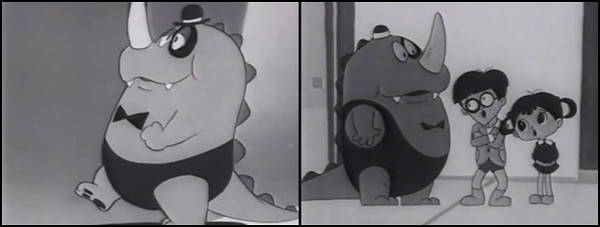
I have to say, even in the 60s, the bowler hat was a bold fashion statement. Guzura was the star of Tatsunoko Productions' third anime TV series, after Space Ace and Speed Racer, and their second (and final) black-and-white series. Rather than a somber tale about mankind fleeing before a terrifying, skyscraper-sized monster, this series is about a silly, oversized lizard who charms his way through society, quickly making friends with a pair of kids. The Godzilla link is strictly unofficial, but obvious—Guzura came along during a kaiju boom, when Godzilla was joined at the movies by films starring the likes of Mothra, Gamera, and Daimajin, and his name sounds an awful lot like 'Gojira.' Still, it's worth mentioning because Guzura was an international hit—the show even aired in English in Australia (and will probably not be seen in that language again because we weren't smart enough to save the films and tapes back then), setting the table for other animated Godzillas and Godzilla-a-likes to come.
That same year of 1967, Godzilla appeared at the movies in Son of Godzilla, where we were introduced to the goofball kid version of Godzilla, Minilla. Yep, by this point, the Godzilla movies had ceased being about Godzilla as a terrifying, destructive warning about what happens if mankind should lose control of our dominion over nature and technology, and were instead about a somewhat friendlier Godzilla who showed up to defend the earth when other monsters came a-stomping (it's a subtle difference, I know). But surprisingly, that '67 movie would set the stage for Godzilla's official debut as a cartoon star—a Saturday morning cartoon star, no less!
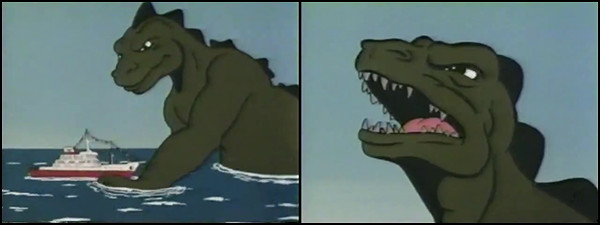
Hanna-Barbera's Godzilla debuted in the fall of 1978, and it's… about what you'd expect from a 70s Hanna-Barbera cartoon, in that it took the basic idea of a big stompy lizard and teamed him up with a bunch of goofy kids and teens, plus the son, or maybe nephew of Godzilla (who's Godzilla's brother-in-law…?), Godzooky. Godzooky had all of the charisma and likeability of Scrappy Doo, but kids watched through the pain—the spectacle of Godzilla was worth it!—and Godzilla fought a variety of adversaries, from giant Atlantean robots to cyborg whales, through two seasons of Saturday morning silliness. What's funny about the H-B series is that American broadcast standards and practices were pretty locked down—very little violence could be shown on a kid's show, and certainly not the collapsing, exploding buildings that are a Godzilla trademark. H-B got suitably creative, giving the big G fire-breath instead of atomic breath, and moving him around to places where thousands of implied casualties and billions in property damage wouldn't be depicted. Interestingly, the Hanna-Barbera series is among the rarest of Godzilla media—Sony released the first TV season in 2006, but those discs go for a pretty penny these days, and the second season has never been released on video. That fancy-schmancy Showa-era film collection from Criterion may be pricey, but at least you can find the damn thing!
Before I continue, let me wind the clock back real quick to 1973, and the film Godzilla vs Megalon. Our fine scaly pal faces off against not just Megalon, but previous Godzilla goon Gigan, but this time he receives help in the form of an unlikely super robot hero with a sinister grin.
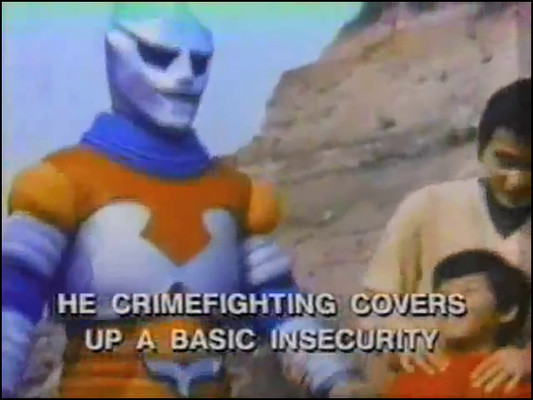
Jet Jaguar was supposed to be the star of this movie, dammit! The character was actually based on the prize-winning creation of a schoolboy, who turned in a drawing of a hero that looked a bit like Ultraman and Mazinger Z pasted together, called Red Alone. The idea of a knockoff Ultraman was a perfectly good one, because various Ultra-sequels had absolutely been ripping up the airwaves, transforming its creator, original Godzilla special effects designer Eiji Tsubaraya, into a rival. Other studios were rushing out their own colorful humanoid tokusatsu heroes, like Spectreman. And so TOHO designed Jet Jaguar, and then realized that he didn't have the juice to carry a whole movie, so they brought in Godzilla. I mention Jet Jaguar for two reasons: first of all, there's a highly-touted but ultimately ineffectual man-made robot in Neon Genesis Evangelion called Jet Alone, and now you know where that came from. Secondly… we'll be seeing Jet Jaguar's disturbing, leering face real soon, because he's in Godzilla Singular Point!
Aside from Hanna-Barbera's Godzilla, the 70s passed without any official Godzilla stuff, but there were a few notable knockoffs and similar heroes. It's really hard to pick a favorite from these, because they're all interesting and bizarre. I'll start with 1972's Goesudae Jeonjaeng, a.k.a. The Great Monster War, a South Korean animated film that manages to combine the spectacle of giant monsters destroying landmarks like the Statue of Liberty and the Arc de Triomphe, and the climactic showdown involving a giant-sized superhuman fighting back, without directly ripping off either Godzilla or Ultraman! It's not like they weren't trying to evoke Godzilla movies, but through a whole lot of weird physical comedy and interpersonal drama, the studio pulled it off. Global animation nerds like to think of Taekwon V as the film that kicked off South Korea's wonderfully bizarre animated movie boom, but it was Great Monster War.
Remember that Eiji Tsuburaya guy, who did the special effects for Godzilla and later created Ultraman? His situation was actually fairly complex, because he continued to do SFX work for TOHO even as his own company flourished. His colorful Ultra-heroes were stealing audiences away from TOHO's monster movies, even while he continued to wield political power at TOHO! He passed away in 1970, but Tsuburaya Productions kept on truckin', first through his eldest son Hajime, and then his son Noboru. Noboru was in charge when Tsuburaya teamed up with a young animation company called Nippon Sunrise to produce Dinosaur Expedition Born Free, a 1976 TV series about a bold exploration corps fighting big live-action lizards. The Tsuburaya name, plus the spectacle of giant reptiles and super-science, definitely gave the proceedings that Godzilla flavor. Even more entertaining was their follow-up Aizenborg, with super-powered animated heroes battling vengeful, intelligent live-action dinosaurs.
The 1980s were a quiet time for Godzilla in animation—with the exception of the legendary Daicon films segments! These films, created as festive introductions to the Japan Science Fiction conventions in 1981 and 1983, represent some of the earliest animated works by the artists who would later form Gainax, including Hideaki Anno and Takami Akai. The films themselves depict an energetic young girl confronting a variety of heroes and villains from across the global sci-fi landscape, so you can spot Star Wars and superhero fare in there, along with cameos from the likes of Ultraman and Atragon. Godzilla himself emerges from the Space Runaway Ideon symbol in the first film, and launches a coordinated attack with a Baltanian (from Ultraman), Gamera, and a Star Destroyer—but he's unable to match the power of a little girl with a randoseru backpack full of missiles. (Someone track her down the next time Godzilla attacks!) These films are far from legal, but they're easy to find online in a variety of formats and qualities.
The 1990s are what would finally bring us the real deal: a Godzilla anime show produced in Japan! Finally, those master crafters of inventive, suspenseful, and cinematic hand-drawn animation that drew fans in droves from around the world would turn their skills towards illuminating one of the country's great monster heroes in animation… for the first time! Sounds exciting, huh?
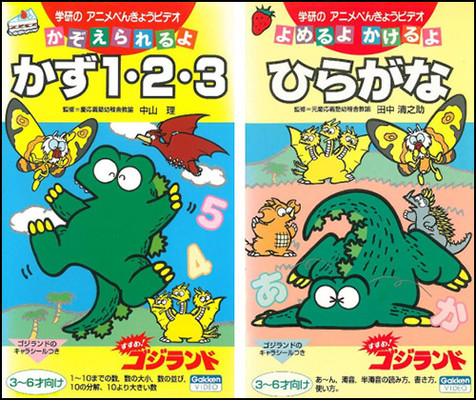
The result, Susume! Godzilla Land, is basically a Godzilla version of Sesame Street. Haha, I sure gassed you up for that one, huh? If you're an ardent kaiju fan, though, this is still a weird, fun little thing to watch—it's the warm spectacle of toddler versions of Godzilla, Mothra, Anguirus, and many others, as they learn how to count, write their hiragana, and socialize with each other. These videos were produced by Gakken in 1994 and 1996, with veteran seiyuu Yūko Mita providing the voice of Godzilla. I wonder if she can do the Godzilla roar? She doesn't do it in this series, unfortunately.
The 1990s were by no means bereft of other Godzilla-adjacent fare, however. An old OVA favorite of mine is Luna Varga, a fantasy adventure based on a light novel about a pretty, gallant princess named Luna. Her kingdom is being invaded, so she awakens an ancient, mysterious power that causes a dragon tail to appear on her back. When it's time to fight, that tail suddenly grows… and pretty much turns into Godzilla. See?
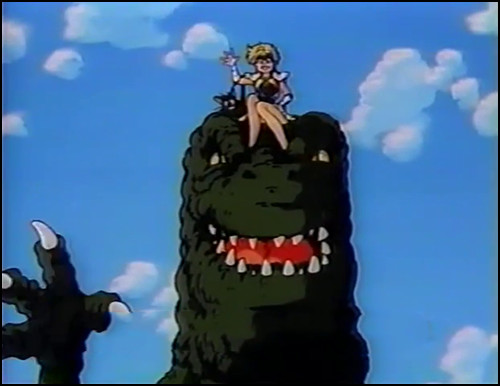
Sorry for the image quality; this series never came out on DVD, and it's a pain to catch a shot that has both Luna and her lizard partner, Varga, in the frame. Varga is, as you can see, a Godzilla, and specifically a Godzilla that wears Luna's butt as a crown. She's literally his brain, so she has to clumsily direct him to attack her enemies and defend her friends. Luna Varga's a reliably fun little action-comedy, and one that absolutely takes cues from the big green lizard.
1998 would bring the infamously lousy Roland Emmerich Godzilla movie, a big-budget Hollywood spectacle starring Matthew Broderick, Jean Reno, and puzzlingly, several actors from The Simpsons. Funnily, aside from the well-remembered 1950s Godzilla: King of the Monsters, which took Ishirō Honda's original movie and inserted Raymond Burr into the proceedings, Godzilla hadn't gotten much traction in Hollywood up to that point. Older fans may remember a thing called Godzilla 1985, but that was a similarly bowdlerized reworking of the Japanese Return of Godzilla. Anyway, what we got was a weirdly boring, low-stakes movie with a lizard that was big and scary, but really lacked personality. To me, that was the 1998 Godzilla's biggest sin—the titular lizard doesn't have a face. It just looks like an animal. But hey, they made a cartoon TV spinoff!
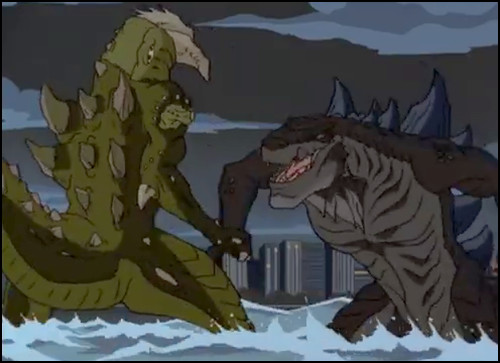
Godzilla: The Series, produced by Columbia Tristar and TOHO and animated by Adelaide Films and seemingly every Korean studio in operation at the time, is probably about as good as a TV series based on the 1998 movie and mainly designed to sell toys could possibly be. It picks right up where the movie left off, with the heroic Nick Tatopoulos (now played by Steve from Beverly Hills, 90210!) raising a fast-growing, friendly young Godzilla and leading a team of heroes called H.E.A.T. in a global mission to track down other emerging monsters, mutants, and mysterious phenomena. They square off against a rogue's gallery of evil industrialists, mad scientists, aliens, and other monsters, and the only other thing I remember is that they had a great running gag about the team's wisecracking robot, Nigel (of course there's a wisecracking robot named Nigel) getting crushed, blown up, or stomped to bits every episode. This series is still really easy to track down, and if you liked anything at all about the 1998 film, check it out. It's also a really compelling piece of American action animation history—not only does it feature anime superfan Tim Eldred as assistant director on the production (I'm sure he'll be writing about it on his fantastic website soon!), it also has a lot of work by future action animation stars like Sam Liu and Jay Oliva. The crews that brought us wonderful 2000s fare like Teen Titans and Spectacular Spider-Man sharpened their skills on this series.
As we wrap up this survey of Godzilla-centric animation, we finally start to draw close to the present day, with Godzilla squaring off against Kong in theaters and the launching of a new anime series. But Godzilla was the star of an anime feature film trilogy just a few years ago—a trilogy created by Polygon Pictures for Netflix (outside of Japan, anyway; inside of Japan, these movies ran in theaters), and directed by Kobun Shizuno, a director who most fans would probably associate with Detective Conan, and of course, that awesome SIN: THE MOVIE OVA from 2000. Shizuno did also direct the first season of Polygon's fine Knights of Sidonia anime series. These films… they're not great, but they're probably the weirdest Godzilla media out there. Yes, they're even weirder than Sesame Street Godzilla!
The idea behind the films, at least, is pretty novel. These movies begin with the premise that Godzilla emerges, as usual, and the human race tries to fight him off, but we can't do it. Eventually, Godzilla (plus some other kaiju doing cameo appearances) drive humanity from the cradle altogether. With the help of a couple of spacefaring alien races, the technology-obsessed Bilusaludo and the space Calvinist Exif, mankind retreats aboard a massive colony ship. 20 years later, unable to find a new place to settle, mankind and their allies limp back to Earth—only, thanks to time dilation brought on by near-lightspeed travel, 20,000 years have passed. What's the world like, and how big is Godzilla now? Pretty big, it turns out.
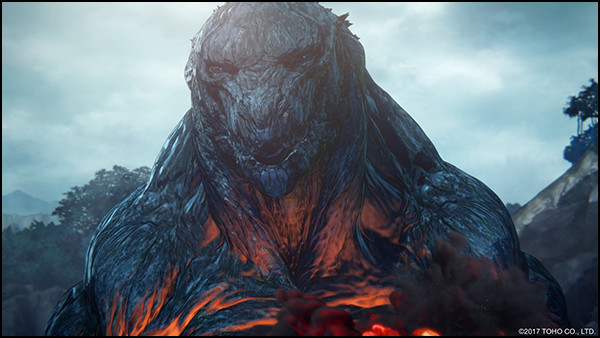
I admire Gen Urobuchi's story for trying to be something different, but the characters in this trilogy, anchored by the dour and vengeful Haruo (named after Godzilla suit actor Haruo Nakajima—a nice touch!), just aren't compelling. It's also nakedly obvious that a lot of props and environmental effects are recycled from previous Sidonia stuff—all of the spacebound ‘sets’ and uniforms have the same grime-speckled look as the previous series. It is definitely kind of neat to see several variations on the ‘classic’ Godzilla, including a giant, silvery one that emerges late in the game, but once again, as with the 1998 film, there's a weird lack of personality to the character in these movies. The films also set up Ghidorah as the big bad guy at the end of the maze, and that doesn't hit quite right, either.
A trio of big-deal Godzilla films written by one of Japan's top screenwriters and produced at an impressive all-CG studio sounds like it should be pretty solid fare, but the end result feels like a bunch of cutscenes from a Halo clone that you've long since lost interest in playing. It's a shame that these movies weren't better—but let's look on the bright side. Godzilla Singular Point is going to be a chance to rewrite history, to finally put down an animated entry truly worthy of the Godzilla name.
As I wrap this piece up, two quick things. First of all, let's not forget that King Kong also is the star of his very own anime series! Well, 1966's King Kong isn't precisely anime—it has character design work by the great Jack Davis, and was developed in America by Rankin-Bass before being shipped over to get animated in Japan. But it's close enough. It's got swingin' characters, a great theme song, and a bad guy called Doctor Who. The following year's King Kong Escapes, which features Kong fighting a monkey-bot, is in fact a TOHO/Rankin-Bass co-production, and explicitly tied to the animated series! They're not as dominant and impressive as the best of Godzilla, but they're interesting fare.
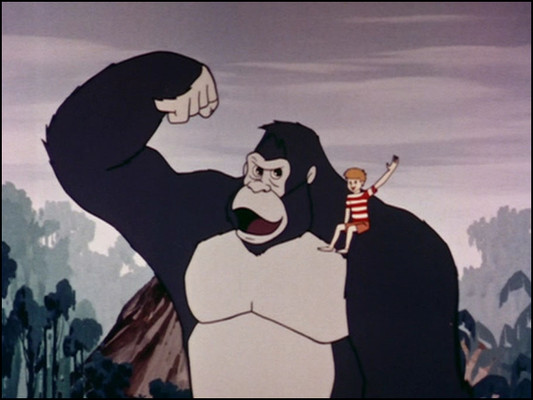
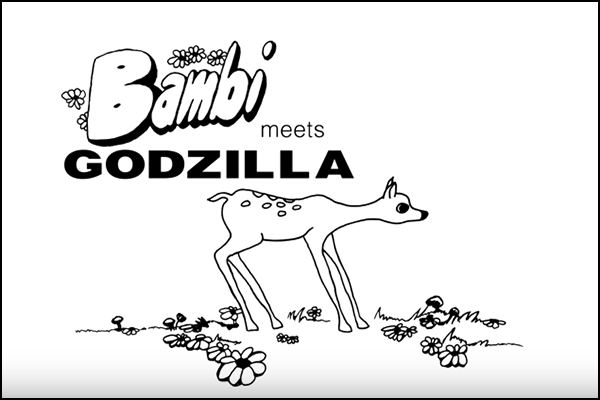
I'll close by tipping my hat to what is certainly the most artistically successful animated version of Godzilla, though it, like the Daicon films, is not an official production. 1969's Bambi Meets Godzilla is a trim 90 seconds long; it's exactly what you expect, and it's brilliant every single time. If you haven't seen it yet, you're in for a treat, and hey, it's got sequels, too! In the final analysis, there may not be all that much ‘real’ Godzilla animation out there—but every city-smashing spectacle, every towering lizard, every wriggling monster emerging from the deep owes a debt to Godzilla. I look forward to more cities getting wrecked!
discuss this in the forum (23 posts) |